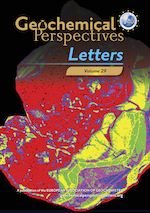 |
Chondritic osmium isotope composition of early Earth mantle
Abstract:
The Ujaragssuit Intrusion, North Atlantic Craton (NAC), Greenland, is thought to host the oldest chromitites (>3.8 Ga) on Earth, showing evidence of both Hadean mantle depletion events and nucleosynthetic isotopic heterogeneities. We set out to verify the age of the intrusion and identify the Os isotope composition of the Ujaragssuit mantle source. Here, we show that the only minimum age constraint is 2970 ± 8 Ma, provided by cross-cutting leucogranites. Concordant Re-Pt-Os isotope ages are consistent with formation of the intrusion from a chondritic primitive mantle source at 3246 ± 120 Ma; mean Pt-depletion ages of 3437 ± 587 Ma offer no direct evidence for Hadean mantle depletion. No nucleosynthetic Os isotopic anomalies could be identified, consistent with large scale Os homogeneity in the presolar nebular. The new ‘young’ age for Ujaragssuit means that nucleosynthetic anomalies occur repeatedly between ∼3.8 and >3.0 Ga in the NAC, suggesting its unique mantle source was repeatedly tapped over ∼600 Myr without significant mixing with the rest of Earth’s mantle. |
 |
Corrigendum to “Sulfur solubility in a deep magma ocean and implications for the deep sulfur cycle” by Steenstra et al., 2022. |
 |
Subduction of sedimentary carbonate in the Mariana trench
Abstract:
Calcium carbonate is a major component of shallow marine sediments but is rarely preserved in deep sea environments below the calcite compensation depth (CCD). In this study, we present evidence of sedimentary carbonate on the subducting Pacific plate of the Mariana Trench at a water depth ranging from 6675 to 10,813 m, far surpassing the local CCD of 4800 m. These deposits consist of well-preserved calcareous nannofossils, planktonic foraminifera, and siliceous radiolarians. Fossil assemblages and isotope stratigraphy analyses constrain the age of carbonate sediments to 17.6–13.5 Ma. We propose that the calcareous sediments originated from rapid deposition and burial on the seafloor above the CCD during the Miocene. Subsequently, they were transported into the hadal zone with the subduction of the Pacific Plate and exposed due to the excavation of extensive subducting-related normal faults within the subducting plate. This study implies that sedimentary carbonate may be a key component of subducting carbon at the hadal subduction zones, which has important implications for evaluating global carbon input fluxes at these zones. |
 |
Barium isotope evidence for a magmatic fluid-dominated petrogenesis of LCT-type pegmatites
Abstract:
Understanding the petrogenesis of granitic pegmatites associated with Li mineralisation is fundamental in constraining rare metal enrichment mechanisms. However, there is still significant controversy surrounding the central issue of the nature of pegmatite-forming liquids. Here, we report Ba isotope data for a 3000 m borehole in the Jiajika pegmatite field that hosts the largest hard rock-type Li deposit in Asia. The pegmatites exhibit markedly lower δ138/134Ba than the wall rocks and the average upper continental crust, which cannot be attributed to low degree anatexis of metasedimentary or crystal fractionation of highly evolved granitic magmas. Instead, modelling suggests that their low δ138/134Ba most likely results from substantial involvement (10–40 %) of isotopically light hydrothermal fluids exsolved from the underlying magmatic reservoirs. In the context of transcrustal magmatic system, these magmatic fluid components may be a key medium in extracting, concentrating, and transporting Li to provide a material source for mineralisation in granitic pegmatites. |
<< Previous issue




